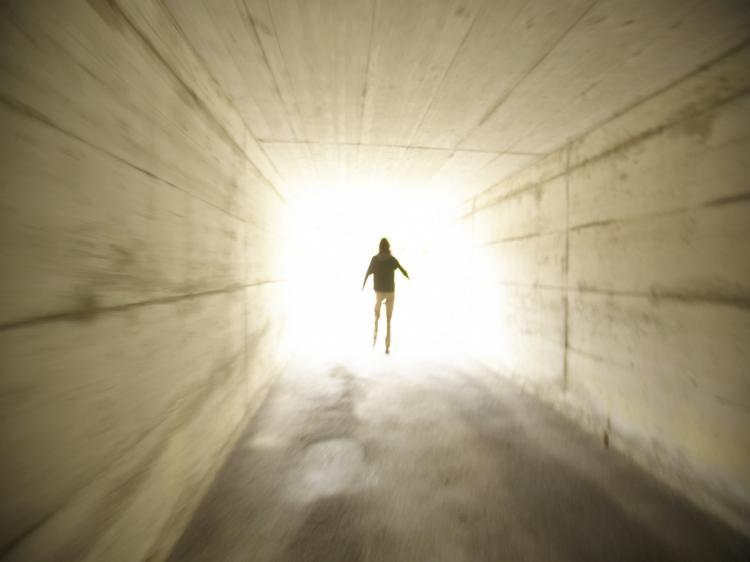In quantum physics, one of the most enduring mysteries is known as the double-slit experiment, which renowned physicist Richard Feynman described as containing “the only mystery.”
So what’s so mysterious about it?
This requires a bit of setup: If you take a light-tight box, and inside shoot photons (basically units of light) through one slit onto photographic paper, you’ll see a pattern where it’s darkest right in the middle, and gets fainter as you move toward the edges. Basically, it’s what you would expect: most of the light hits the middle, and the rest of the photons get deflected to various degrees and stray from the middle in predictable ways.
If you change your apparatus and introduce a second slit, and shoot photons through it, you’ll now get an interference pattern—alternating bands of dark and light. What’s happening is the light is acting like a wave on its way to the photographic plate, and the two beams of light are interfering with each other. Sometimes they reinforce each other, and sometimes they cancel each other out.
Now here’s where it gets really interesting: if you shoot one photon at a time through the device, but don’t know which slit the photon goes through, you still get the interference pattern!
But if you shoot one at a time, and you know which slit it goes through, you’ll just get two clusters, like when there’s only one slit open, but in two places.
Numerous theoretical explanations have been offered to explain this mystery, some of which propose that the act of observation by a conscious entity—a mind—plays a crucial role. The act of observation, in effect, alters the state of matter at the quantum level.
This is controversial, probably because it doesn’t fit with the prevailing scientific worldview that matter and energy are primary, and consciousness is more or less something extra, and has nothing to do with the most basic constituents of the universe. If mind isn’t just as fundamental as matter, how could it affect matter at a quantum level?
There are problems with the view that matter is primary and consciousness comes later, but the best way to demonstrate that is probably with experiments, rather than philosophical arguments. (After all, such philosophical arguments have been going on for a long, long time.)
What if it could be shown experimentally that consciousness can affect the results of the double-slit experiment?
The Experimental Evidence
Enter Dean Radin and colleagues, who carried out a series of six experiments demonstrating just this.
Participants were first familiarized with the double-slit experiment by watching a 5-minute animation, then they were brought into an electrically shielded steel room, sat down a few meters from the double-slit apparatus, and were given instructions to try to influence the beam when told to do so.
During randomly assigned periods lasting from 15 to 30 seconds, participants were cued to relax or to try to influence the apparatus. Each session lasted about 15 minutes, not including instruction.
Radin and colleagues found that during those periods when participants were attending to the device, the interference pattern was significantly reduced, compared to when the device was active but no one was present. That means it looked more like when there’s knowledge of which slot the light passed through.
They controlled for various factors, such as electrical shielding, temperature, and vibration, but none of these could explain away the results: focused attention influenced the pattern of light.
And how good one is at focusing turns out to be an especially important factor. Participants’ amount of meditation experience made all the difference as to whether they could affect the pattern or not—those who did not practice meditation on average failed to show a statistically significant effect.
Somehow, those who regularly practice focusing their attention can have more of an effect on this quantum phenomenon.
This brings up a host of new questions: how does focused attention affect this or other phenomena? Are these meditation practitioners different than other people, or is it the meditation itself that produces the effects? If it is amount of practice, what exactly is it about meditation that produces this capability?
Regardless of the answers to those questions, these six experiments present strong statistical evidence that meditators are capable of influencing quantum events. To get these results by chance, you’d have to run the same set of experiments 150,000 times. In contrast, for most psychology studies, if you would arrive at a particular result by chance one out of 20 times, it is considered a valid effect.
Radin and colleagues also examined whether fluctuations in the Earth’s geomagnetic field might be responsible for the results, because previous studies have shown that these magnetic variations are linked to various phenomena related to human behavior, such as stock market activity, suicides, and cardiac health, as well as differences in performance on extra-sensory perception (ESP) tasks.
They found that the results of these experiments are not explained by these variations, but the variations contributed to how strong the effects were, thus further validating that both these geomagnetic influences and the effect on the double-slit experiment are real.
The study was published in Physics Essays, June 2012.




